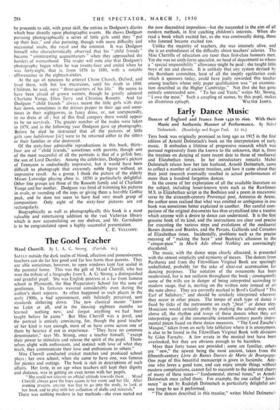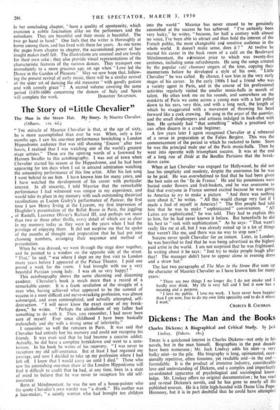Early Dance Music
Dances of England and France from 1450 to 16oe. With their Music and Authentic Manner of Performance. By Mabel Dolmetsch. (Routledge and Kegan Paul. £2 2s.) Tars book was originally promised as long ago as 1915 in the first edition of Arnold Dolmetsch's book on the interpretation of early music. It embodies a lifetime of progressive research which was pursued regressively from the known to the unknown, that is, from the treatises on dancing of more recent date to those of mediaeval and Elizabethan times. In her introductory remarks Mabel Dolmetsch relates how her late husband, Arnold Dolmetsch, came to collect a number of ancient treatises, and how it came about that their joint research eventually resulted in actual performances of more than a hundred forgotten dances.
In the course of her exploration of all the available literature on the subject, including lesser-known texts such as the Rawlinson M.S. in Elizabethan script in the Bodleian and a poem in macaronic verse by the sixteenth-century Provencal poet, Antonius de Arena, the author soon realised that what was omitted or ambiguous in one book was sometimes better explained in another. Her careful com- parison of the original documents has thus crystallised into a treatise which anyone with a desire to dance can understand. It is the first genuine book of its kind, and the instructions are clear and precise for executing the various steps and evolutions of the mediaeval Basses danses and Branles, and the Pavans, Galliards and Corantos of Elizabethan times. Incidentally, problems such as the precise meaning of "making the haye " and Beatrice's allusions to the " cinque-pace " in Much Ado about Nothing are Convincingly elucidated.
The music, with the dance steps clearly allocated, is presented with the utmost simplicity and economy of means. The dances from Parthenia and from the Fitzwilliam Virginal Book are sparingly embellished, probably for the sake of clear-cut accentuation for dancing purposes. The notation of the ornaments has been modernised, but is not uniform throughout the book ; consequently some of the trills are in 'danger of being interpreted according to modern usage, that is, starting on the written note instead of on the note above. They are correctly marked in Byrd's Galliard "The Earl of Salisbury," and should be similarly interpreted wherever they occur in other pieces. The tempo of each type of dance is fixed by ticks of the metronome on each ',beat" or dance step. Musicians would certainly profit by studying the actual steps and, above all, the rhythm and tempi of these dances when they are interpreting any of the innumerable sixteenth-century purely instru- mental pieces based on these dance measures. "The Lord Zouche's Masque," taken from an early lute tablature where it is anonymous, is also to be found in the Fitzwilliam Virginal Book with divisions by Giles Farnaby. A few errata in the musical text have been overlooked, but they are obvious enough to be harmless.
More than forty tunes are provided ; some are familiar, others are "new," the newest being the most ancient, taken from the fifteenth-century Livre de Basses Danses de Marie de Bourgogne. One page of this beautiful manuscript is given in facsimile. Any- one who loves a good tune, and call enjoy simple things without modern complications, cannot fail to succumb to the inherent charm of many of these tunes—" fundamental, eternal tunes," as Arnold Dolmetsch once called them. For example, the one called " Jouis- sance " as set by Rudolph Dolmetsch is particularly delightful and one longs to see it performed.
"The dances described in this treatise," writes Mabel Dolmetsch in her concluding chapter, "have a quality of spontaneity, which exercises a subtle fascination alike on the performers and the onlookers. They are beautiful and their music is beautiful. The two go hand in hand." One feels that the writer is thoroughly at home among them, and has lived with them for years. As one turns the pages from chapter to chapter, the accumulated power of her insight makes itself felt. The illustrations are unusual and are lovely for their own sake ; they also provide visual representations of the characteristic features of the various dances. They transport one ,immediately to a more gracious age, an age when "Love led the Dance in the Garden of Pleasure." May we now hope that, follow- ing the present revival of early music, there will be a similar revival of the sister art of dancing the old measures "with goodly gesture and with comely grace " ?. A second volume covering the same period (1450-1600) concerning the dances of Italy and Spain will complete the work. DOROTHY SWAINSON.



































 Previous page
Previous page